The benefits of running in minimalist shoes and the damaging effects of cushioned running shoes are becoming more clear. The reasons more and more runners are turning to minimalist shoes is because they’re well on record for producing immediate improvements in overall running form and foot health that get better with time vs standard running shoes.

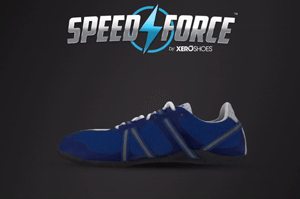
Firmly established research by Kim et al. in the Journal of Biomechanics revealed that harder landing surfaces, like when running in minimalist shoe because they lack cushioning thereby making your landing surface more firm than soft, makes your stride more spring-enabled (more energy efficient), which causes your muscles to perform less mechanical work, and therefore, expend less metabolic energy vs softer, cushier landing surfaces, like when running in thick cushioned running shoe.
- A spring-enabled stride when running means the Achilles tendon and the arch of foot are more effective at storing and releasing elastic energy, which makes your stride more spring loaded, which in turn, launches you into the next step with less muscular effort and less muscle energy.
- What’s so interesting is the harder the landing surfaces when running, the more spring-loaded your stride becomes, which lowers energy costs, whereas softer landing surfaces makes your stride, essentially, a sloppy spring (i.e. less spring-enabled) that requires more expensive muscle power to propel the body forward.
Indeed, minimalist running shoes are spring-enhancers for your stride because they create an optimal landing surface that is more firm which enhances spring loading in the arch and Achilles, allowing increases in spring energy, and the best part is, good running economy requires elastic energy.
Harder Surfaces Better for Knees in Every Way, Too!
Even better, harder landing surfaces when running was found to (references below article) improve knee mechanics by enabling your knee-joint to slightly bend and flex at landing, which also helped enhance leg-spring, and thus energy return. How so?
- When the knee-joint bends at landing during running, the foot lands closer to the center of mass (hips), creating a mass-spring effect where the mass of the torso loads down onto the springs (i.e. the foot’s arch and Achilles tendon), creating better spring compression to pop you into your next step, thereby making your stride even more spring-enabled, and less reliant on muscle power/energy.
In this scenario, minimalist shoes come into play because the enhanced ground-feel was found to regulate knee-joint flexion by engaging a forefoot strike. The forefoot strike makes your knee flex at landing, whereas heel strike running (which is often a major side-effect of running thick, cushioned heeled running shoes, makes your knee-joint unbend at landing, creating an over-stride where the foot is not placed near your torso, rather its lands too far ahead, all shown below:
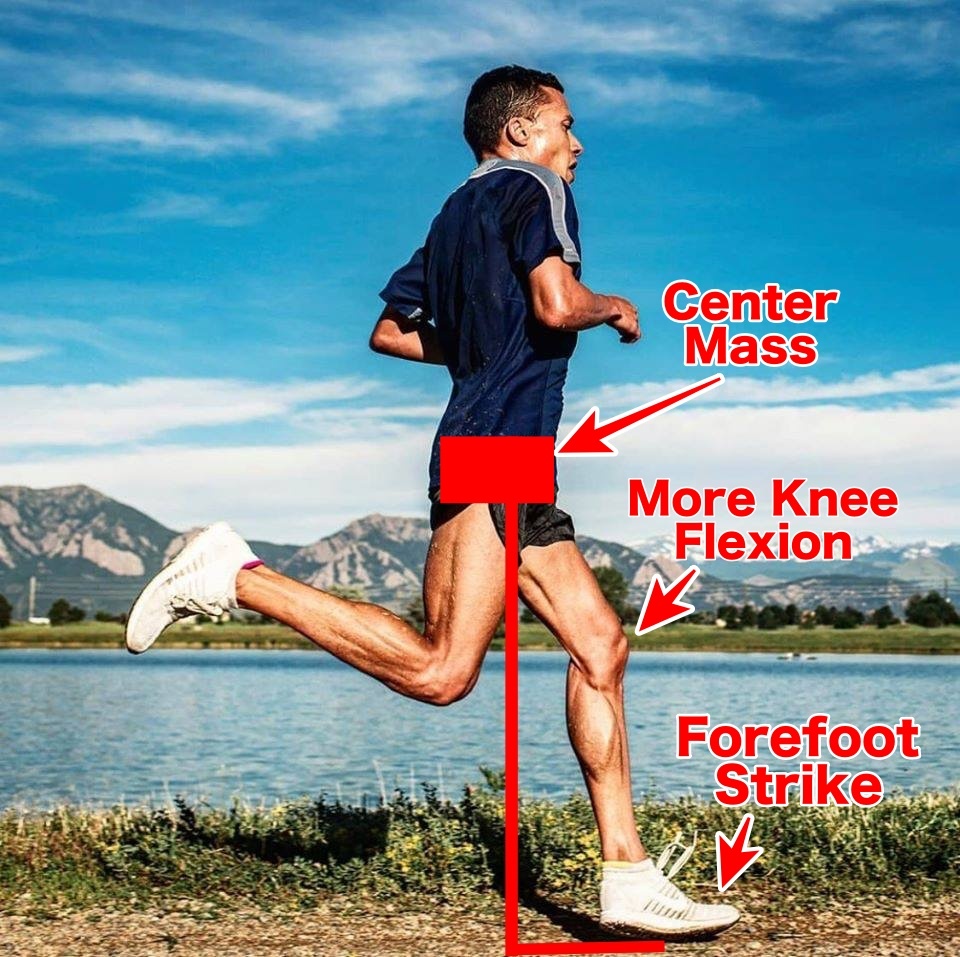
All in all, leg-spring capacity is directly related to running surfaces as well as biomechanics. To farther enhance the spring properties of the elastic structures in the lower level, landing with a forefoot strike promotes energy efficiency by loading more elastic energy into the arch and the Achilles tendon. This does not happen in heel strike running because it has a different effect on your entire stride mechanics that makes your leg a sloppy, ineffectual spring. Read more on that here!
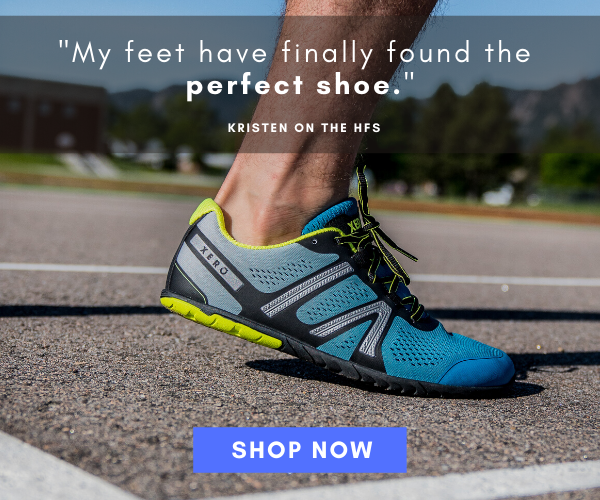
It’s also been well reported that foot strike can have a big influence on either enhancing or impeding the energy-saving spring properties of the arch and the Achilles. Landing with a forefoot strike gives you more access to spring energy
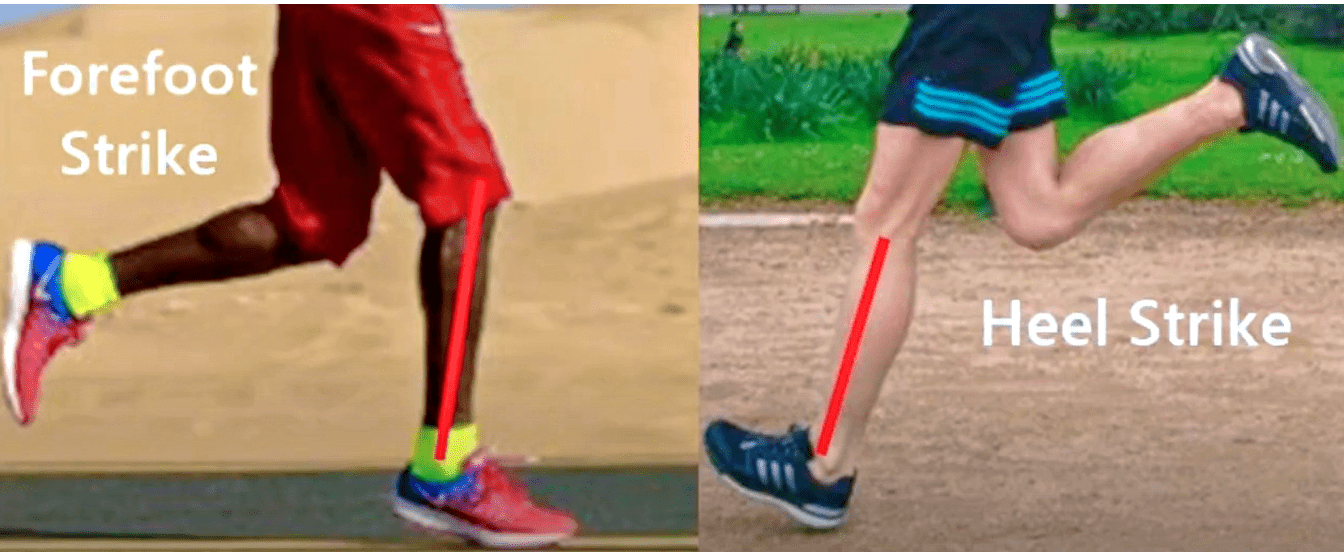
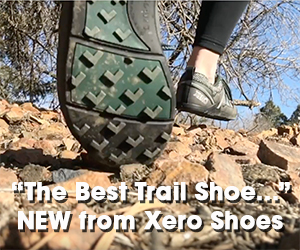
Forefoot running is better at optimizing leg-spring, while protecting the arch and Achilles from high impact as than heel strike running,
- The body naturally adjusts leg-spring capacity in response to different surfaces while similar running mechanics are maintained.
- For instance, in addition to a forefoot strike landing, increased knee flexion and ankle plantar flexion is an adaptation to running barefoot on hard surfaces.
- These variables not only allow barefoot runners to escape the confines of injury, but maximizes leg-spring.
The problem with cushioned running shoes is that they reverse the kinematic adaptations induced by barefoot running. That is, knee flexion decreases and so does ankle plantar flexion. One explanation for this apparent paradox is that the plantar surface is perceived as comfortable in cushioned running shoes.
This is why increased knee flexion is not needed to provide additional comfort when running in cushy shoes, however it IS needed for better running economy! Remember: increased knee flexion = better leg-spring.
The Harder, the Better
Until recently, the notion that barefoot running enhanced performance seemed absurd. Now, the relationship between barefoot running and leg-spring capacity is becoming more thoroughly studied.
The evidence is now very convincing, especially since the best runners in the world grew up running barefoot and evolved adaptations of better leg-spring capacity than runners of habitual shod populations.
More From Run Forefoot:
- Is Barefoot Running Bad?
- The Meaning of Calf Soreness in Forefoot Running
- How Forefoot and Heel Running Effects Achilles Function
- What are the Proper Shoes for Forefoot Running
References:
Ferris, D.P., Liang, K., Farley, C.T., 1999. Runners adjust leg stiffness for their first step on a new running surface. Journal of Biomechanics 32 (8), 787–794.
Ferris, D.P., Louie, M., Farley, C.T., 1998. Running in the real world: adjusting leg stiffness for different surfaces. Proceedings of the Biological Sciences 265 (1400), 989–994.
Kim et al. The natural frequency of the foot-surface cushion during the stance phase of running. J Biomech, 2011; 44:774-79.
Kim, W., Voloshin, A.S., Johnson, S.H., 1994. Modeling of heel strike transients during running. Human Movement Science 13, 221–244.
Robbins SE., Hanna AM and Jones, L. Sensory attenuation induced by modern athletic footwear. J Test Eval, 1988; 16:412-16.

I don’t think the title of your article matches the content lol. Just kidding, mainly because I had some doubts after reading the article.